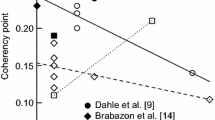Abstract
A complex mathematical model of aluminum casting and solidification in a variable electromagnetic field is constructed. The model is based on the solution of magnetohydrodynamic equations and the VOF method. Test results are presented for the model and the numerical algorithm proposed. The numerical results are compared with experimental data and computations of other authors and are found to be in good agreement. The model is used to simulate aluminum solidification under an electromagnetic field. The physical processes influencing ingot formation are analyzed.
Similar content being viewed by others
References
Z. N. Getselev, Continuous Casting in Electromagnetic Crystallizer (Metallurgiya, Moscow, 1983) [in Russian].
M. V. Pervukhin, A. V. Minakov, N. V. Sergeev, and M. U. Khatsauk, “Mathematic simulation of electromagnetic and thermal hydrodynamic processes in the ‘inductor–ingot’ system of an electromagnetic mould,” Magnetohydrodynamics 47 (1), 79–87 (2011).
A. V. Minakov, M. Yu. Khatsayuk, and M. V. Pervukhin, “Numerical simulation of free-surface dynamics and solidification in electromagnetic crystallizer,” Indukts. Nagrev 27 (1), 37–42 (2014).
M. Kirpo, PhD Thesis (University of Latvia, 2008).
O. Pesteanu and E. Baake, “Contribution to the simulation of free surface flows in electromagnetic field,” Proceedings of the 54th International Scientific Colloquium on Information Technology and Electrical Engineering: Devices and Systems, Materials and Technologies for the Future (Technische Universität Ilmenau, 2009), pp. 361–362.
S. Spitans, A. Jakovics, E. Baake, and B. Nacke, “Numerical modeling of free surface dynamics of conductive melt in the induction crucible furnace,” Magnetohydrodynamics 45 (4), 425–436 (2010).
E. Baake, A. Muhlbauer, A. Jakowitsch, and W. Andree, “Extension of the k–e model for the numerical simulation of the melt flow in induction crucible furnaces,” Metal. Mater. Trans. B 26, 529–536 (1995).
J. O. Hinze, Turbulence (McGraw-Hill, New York, 1975).
S. V. Patankar, Numerical Heat Transfer and Fluid Flow (Hemisphere, Washington, 1980; Energoatomizdat, Moscow, 1984).
Yu. A. Bystrov, S. A. Isaev, N. A. Kudryavtsev, and A. I. Leont’ev, Numerical Modeling of Vortical Intensification of the Heat Transfer in Tube Banks (Sudostroenie, St. Petersburg, 2005) [in Russian].
J. H. Ferziger and M. Peric, Computational Methods for Fluid Dynamics (Springer, Berlin, 2002).
F. R. Menter, “Two equation eddy viscosity turbulence models for engineering applications,” AIAA J. 32 (8), 1598–1605 (1994).
F. R. Menter, “Review of the SST turbulence model experience from an industrial perspective,” Int. J. Comput. Fluid Dyn. 23, 20–35 (2009).
C. W. Hirt, “Volume of fluid (VOF): Method for the dynamics of free boundaries,” J. Comput. Phys. 39, 201–226 (1981).
A. V. Minakov, “Numerical algorithm for moving-boundary fluid dynamics problems and its testing,” Comput. Math. Math. Phys. 54 (10), 1560–1570 (2014).
J. U. Brackbill, D. B. Kothe, and C. A. Zemach, “Continuum method for modeling surface tension,” J. Comput. Phys. 100, 335–354 (1992).
A. A. Gavrilov, A. V. Minakov, A. A. Dekterev, and V. Ya. Rudyak, “A numerical algorithm for modeling laminar flows in an annular channel with eccentricity,” Sib. Zh. Ind. Mat. 13 (4), 3–14 (2010).
F. F. Tsvetkov and B. A. Grigor’ev, Hear and Mass Exchange (Mosk. Energ. Inst., Moscow, 2005) [in Russian].
L. D. Landau and E. M. Lifshitz, Electrodynamics of Continuous Media (Nauka, Moscow, 1982; ButterworthHeinemann, Oxford, 1984).
V. Ya. Rudyak, A. V. Minakov, A. A. Gavrilov, and A. A. Dekterev, “Application of new numerical algorithm for solving the Navier–Stokes equations for modeling the work of a viscometer of the physical pendulum type,” Thermophys. Aeromech. 15, 333–345 (2008).
B. P. Leonard, “A stable and accurate convective modeling procedure based on quadratic upstream interpolation,” Comput. Math. Appl. Mech. Eng. 19, 59–98 (1979).
C. M. Rhie and W. L. Chow, “Numerical study of the turbulent flow past an airfoil with trailing edge separation,” AIAA J. 21 (11), 1525–1532 (1983).
U. Trottenberg, C. W. Oosterlee, and A. Schüller, Multigrid (Academic, New York, 2001).
O. Ubbink, PhD Thesis (Imperial College of Science, Technology and Medicine, London, UK, 1997).
M. Hinatsu, “Two-phase flows for joint research,” Proceedings of SRI-TUHH Mini Workshop on Numerical Simulation of Two-Phase Flows (National Maritime Res. Inst., 2001).
K. B. Neilsen, PhD Thesis (Technical Univ. of Denmark, 2003).
L. G. Loitsyanskii, Mechanics of Liquids and Gases (Nauka, Moscow, 1970; Pergamon, Oxford, 1972).
C. Gau and R. Viskanta, “Melting and solidification of a pure metal from a vertical wall,” Trans. ASME: J. Heat Transfer 108, 171–174 (1986).
Author information
Authors and Affiliations
Corresponding author
Additional information
Original Russian Text © A.V. Minakov, M.V. Pervukhin, D.V. Platonov, M.Yu. Khatsayuk, 2015, published in Zhurnal Vychislitel’noi Matematiki i Matematicheskoi Fiziki, 2015, Vol. 55, No. 12, pp. 2094–2108.
Rights and permissions
About this article
Cite this article
Minakov, A.V., Pervukhin, M.V., Platonov, D.V. et al. Mathematical model and numerical simulation of aluminum casting and solidification in magnetic fields with allowance for free surface dynamics. Comput. Math. and Math. Phys. 55, 2066–2079 (2015). https://doi.org/10.1134/S096554251512009X
Received:
Accepted:
Published:
Issue Date:
DOI: https://doi.org/10.1134/S096554251512009X




